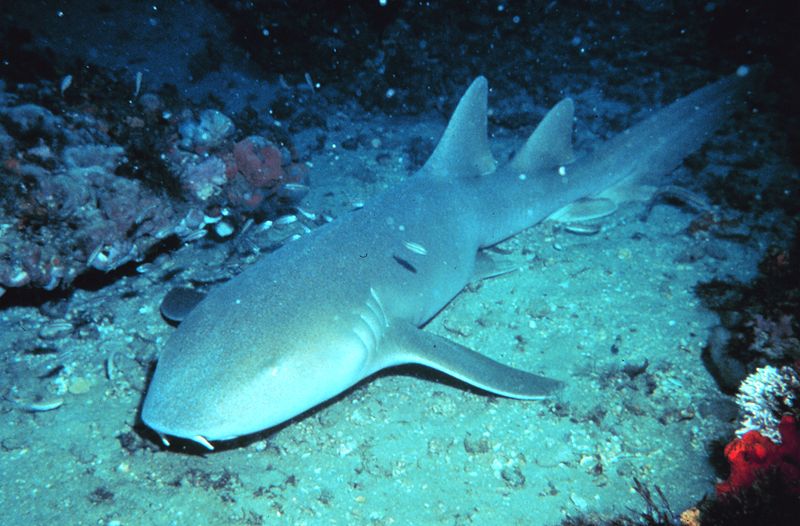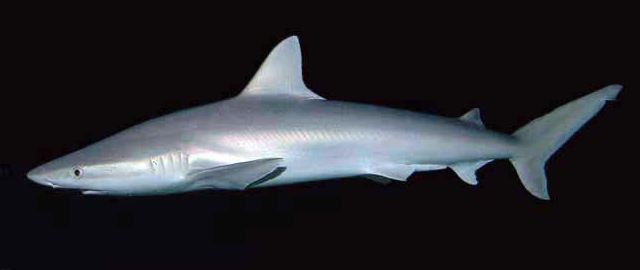Tulum is a municipality located in the Mexican state of Quintana Roo in the eastern half of the Yucatán Peninsula. Surrounded by tourist hotspots, such as Cancún and Cozumel, Tulum is known for its beautiful, white sandy beaches that face the Caribbean Sea.
Along with its beaches, Tulum has preserved ruins from the ancient Mayan civilization that resided in the Yucatán around 2600 B.C. You can visit the Tulum archeological site in El Castillo, which features a large stone structure that was once a temple.
The Mesoamerican Barrier Reef stretches along the coast of Tulum, beginning at the tip of the Yucatán and extending down towards Honduras. This reef boasts an abundance of marine life, including sea turtles and manatees.
But if you’re planning on vacationing here, you might have one big question:
Does Tulum, Mexico have sharks? Is it safe to swim, surf, and snorkel in Tulum?

Some of the most common Tulum sharks that may be seen in coastal waters include:
- Whale sharks
- Nurse sharks
- Chain catsharks
- Caribbean reef sharks
- Tiger sharks
- Bull sharks
- Atlantic shortfin mako sharks
- Blacknose sharks
Shark attacks in Tulum, Mexico, however, are quite rare. The entire Quintana Roo region has only seen 10 confirmed attacks in the last 100+ years — making Tulum a very safe getaway spot for vacationers and beach-goers.
Let’s take a closer look at the types of sharks that live near Tulum, Mexico — including photos, shark attack history and statistics, and more from the Yucatán Peninsula!
Types of Sharks at Tulum, Mexico
The coral reef off the Tulum coast attracts many marine life species. Tulum faces the Caribbean Sea, and the Gulf of Mexico borders the other side of the Yucatán Peninsula.
Between these two bodies of water, there are several shark species that may pop up around the Tulum Coast.
The main heavy hitters are whale sharks, tiger sharks, and bull sharks.
Whale sharks are more abundant in Mesoamerican Reef waters than anywhere else in the world. Tiger and bull sharks are the most aggressive species on this list that may appear in Tulum waters.
Let’s dive into interesting facts about each of these sharks and the probability of sighting one while visiting Tulum, Mexico!
Whale Shark

Massive whale sharks can be found in tropical and warm temperate waters worldwide, except for the Mediterranean Sea.
The largest whale shark population is found in the Mesoamerican Barrier Reef.
These sharks are considered a benthic species. This means they like to live on or close to the ocean floor. They are commonly sighted offshore, but may travel inshore around coral atolls.
Even though they live near Tulum, it’s unlikely you’ll encounter a whale shark because they travel close to shore often. They are also not aggressive sharks, and are not considered a threat to humans.
If you ever stumble upon a whale shark feeding site, it’s likely you’ll see hundreds or even thousands congregating. They are very large, reaching lengths up to 32 ft.
Whale sharks are only one of three shark species that are filter feeders. They will travel through the water with their mouth open as wide as 4 ft to consume anything that may be in their path.
Nurse Shark

Nurse sharks are slow-moving, nocturnal creatures found in subtropical and tropical coastal waters. They like to inhabit coral reefs to feed on a variety of bony fishes, crustaceans, and squid.
As bottom-dwellers, nurse sharks typically lie on sandy bottoms during the day and search for food at night. They don’t migrate and are more active in the warmer months.
Nurse sharks may not be a common sight in Tulum waters during the day in colder months due to their behavior.
Only nine non-fatal nurse shark attacks have been recorded in the International Shark Attack File since 1580. These sharks are fairly small compared to other species. They may reach up to 9 ft in length and weigh as much as 230 pounds.
They are not considered aggressive and typically swim away when encountered.
Chain Catshark

The chain catshark is the smallest shark species on this list. The largest male recorded was only 1.6 ft in length.
They have an intricate color pattern of dark alternating lines and blotches over a reddish brown to light tan body.
Chain catsharks are most abundant along the central eastern coast of the U.S. in the Atlantic. They can also be found in northern Gulf of Mexico waters down to Nicaragua.
Catsharks that reside in the northern Atlantic waters are more likely to be spotted near the surface.
Southern chain catsharks swim at lower depths up to 1,476 ft. They are a bottom-dwelling species and may only appear closer to coasts to feed on small bony fishes and crustaceans.
Due to their small size and preferred deep water habitat, chain catsharks are not considered a threat to humans.
Caribbean Reef Shark

As the name suggests, Caribbean reef sharks are mostly found in the Caribbean Sea. They may be commonly sighted along the Yucatán coast, but can easily be confused with other requiem shark species.
Caribbean reef sharks are inshore bottom-dwellers that reside near continental and insular shelves. They frequent coral reefs to feed on bony fishes.
They are considered an apex predator and can grow up to 10 ft in length.
Despite their intimidating size, these sharks are not aggressive. Only four attacks have been reported in the last 400 years, according to the International Shark Attack File.
Tiger Shark

Tiger sharks are a highly adaptive species. They can be found in coastal waters throughout the world, except the Mediterranean Sea. They also live around oceanic islands.
The tiger shark is a large shark that can reach lengths up to 18 ft and weigh as much as 1,400 pounds!
They get their name from their distinct color pattern, which features gray stripes or spots.
These sharks are often called the garbage cans of the sea because they will eat pretty much anything. They are slow swimmers, but produce a quick burst of speed when attacking prey.
Tiger sharks are second to the great white shark for most attacks recorded.
They are known to be aggressive and dangerous to humans. Still, tiger sharks have been responsible for just 102 non-fatal and 36 fatal attacks since the late 16th century.
Bull Shark

Bull sharks are found all around the world in tropical and subtropical waters. They frequent very shallow waters closer to shore, typically less than 100 ft deep.
They have also been known to frequent freshwater and travel far inland in rivers.
Named for their large snouts, bull sharks are big sharks that can reach lengths up to 13 ft and weigh as much as 698 pounds. They can be hard to identify because they look like most requiem sharks, with gray backs and white underbellies.
Bull sharks are not picky eaters. They like to eat bony fishes, dolphins, other sharks, birds, and terrestrial animals.
Bull sharks are one of the more aggressive sharks found in Central American waters. Their shark attack history may not be accurately reported since they don’t have distinct characteristics that may separate them from other requiem sharks.
According to the International Shark Attack File, bull sharks are responsible for 95 non-fatal and 26 fatal attacks.
Their large size, aggressive behavior, and preferred shallow water habitat make them a potentially dangerous species.
Atlantic Shortfin Mako Shark

Atlantic shortfin mako sharks are found along the eastern coast of the United States down to Florida and throughout the Caribbean and Gulf of Mexico. These sharks are highly migratory and are capable of traveling across different seas.
These sharks can reach lengths up to 14.5 ft long and move extremely fast.
The shortfin mako shark is the fastest-known shark species in the world. They can swim up to 30 mph. They are also capable of bursts of speed up to 45 mph!
Thanks to their speed and large size, these sharks are at the top of their food chain. They are considered an aggressive predator and can become a dangerous threat when provoked.
In 2018, the Atlantic shortfin mako was classified as an endangered species. Their population has declined significantly due to recreational and commercial fishing.
Blacknose Shark

Blacknose sharks live along the coast of the Yucatán, and the southeastern coast of the U.S. down to southern Brazil.
These sharks are named for the black spot they possess on the tip of their nose. Blacknose sharks are quite small, reaching only 4 ft in length.
The blacknose shark is an inshore species that can be found at depths between 59 and 210 ft. Adults don’t frequent shallow waters as much as juveniles.
These sharks are quick swimmers, but they aren’t considered a threat because of their small size.
They will hunch their backs as a warning display when threatened.
Shark Attack History at Tulum, Mexico
Shark attacks in Tulum and the Quintana Roo state are extremely rare.
Most shark attacks reported in this area were off the coast of Cancún or the island of Cozumel. These are very popular tourist areas, which could contribute to the number of attacks.
Sharks are present in Tulum waters, but there are no shark incidents reported in this specific area.
There have only been 10 shark attacks reported in the Quintana Roo region since 1900.
Sharks have been spotted in Caribbean waters off the eastern Yucatán coast. In March 2021, Playa del Carmen in Cancún was shut down due to shark sightings in shallow waters. This beach is about 40 miles north of Tulum.
A month earlier, another Cancún beach called Playa Xcalacoco was shut down after sharks were spotted in the water.
About 130 miles south of Tulum, a 15-year-old boy was attacked by a shark in Mahahual. He suffered severe injuries to his arm, but the incident was non-fatal.
The most common time for sharks to appear close to shore in Tulum and surrounding beaches is between November and March.
This is when female sharks typically give birth to their young in shallow nursing grounds.
Wrapping Up
There are several shark species that live in the Gulf of Mexico and Caribbean Sea. The most aggressive sharks that may frequent Tulum waters include the bull and tiger shark.
Beaches in the Tulum area have shut down due to shark sightings to keep visitors safe. Shark sightings may be more common between November and March, as female sharks give birth during this time.
Although a scant number of shark attacks have occurred in surrounding areas, Tulum itself does not have any shark incidents as of 2022. Based on these records, Tulum is considered a safer vacation spot than other Yucatán tourist hotspots.
For more, check out:
Hope this helps!